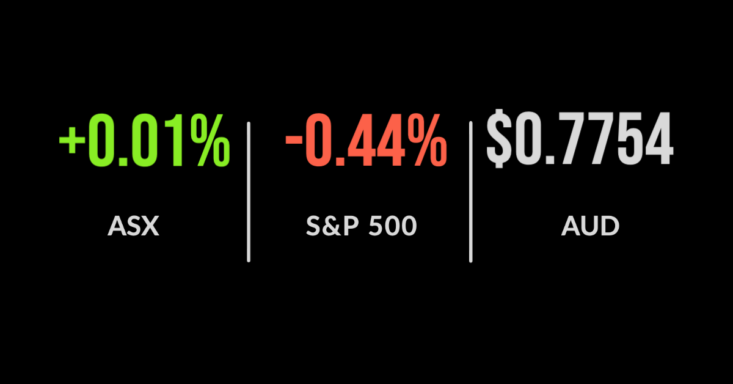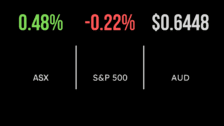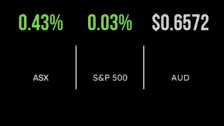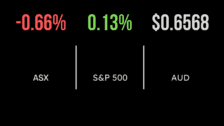ASX finishes flat, Wesfarmers delivers again
ASX finishes flat, CSL (ASX:CSL), Wesfarmers (ASX:WES) delivers again, Fortescue (ASX:FMG) delivers record dividend
The ASX200 (ASX:XJO) finished flat for the day, but with growing dispersion in underlying company performance.
Treasury Wine (ASX:TWE) lead the way, jumping 17.5%, but it was healthcare company CSL (ASX:CSL) that contributed most with the consumer discretionary (+0.6%) and the healthcare (+2.0%) the few winners.
Unemployment also continued to fall, down to 6.4%, after 30,000 new jobs were created.
It was one of the busiest days of reporting season for larger companies, with two of Australia’s best managed groups reporting.
The first was Wesfarmers (ASX:WES) which finished 0.6% higher after reporting a 16.6% increase in revenue, with operating leverage sending net profit for the year up 25.5%.
The standout remains the Bunnings and Officeworks franchises, which saw sales increase 24.4% and 23.7% in the first half on 2019 levels, with the former remaining the key cash flow driver of the business.
The pandemic forced Bunnings to finally embrace online sales, jumping 125% across the group in total, which has seen an expansion in profit margins.
Free cash flow improved 89% on the previous year, however, this included the acquisition of Kidman Resources and Catch Group.
The dividend was increased by 17.3%, with the most powerful news being the decision to proceed with a $950 million investment into the Mt Holland Lithium project as the group pivots to the electric vehicle market.
CSL (ASX:CSL) managed to overcome the headwind of a falling USD to deliver a 44% increase in profit to US$1.81 billion, announcing a record dividend, +9% to US$1.04 per share.
The result was driven by exceptionally strong growth in the influenza division, Seqirus, which reported a 38% increase in revenue.
The core CSL Behring added 9% whilst the decision to change distribution channels into China is clearly paying off with sales of the Albumin treatment +93% on the prior period.
The company has overcome concerns of lower blood collections in the US, which were 80% of 2019 levels, and has managed to solidify its monopoly during the pandemic without profiting from the manufacture of a COVID-19 vaccine.
The long-awaited CSL112 treatment for cardiovascular diseases has also enrolled 11,500 patients into a Phase 3 trial in a positive step forward.
This was another strong report from CSL, which now has an extensive pipeline of growth opportunities supported by a fast-growing but mature base; shares finished 2.8% higher.
Origin Energy (ASX:ORG) delivered a previously flagged 98% fall in profit, down from $599 million in the previous year.
The weakness was not unexpected, driven by lower wholesale electricity prices due to weaker demand amid the pandemic along with lower oil and gas prices in their production and Energy Markets division.
The recent rally in the oil price is expected to feed into the second half of the year with the price now around US$60 per barrel, offering a potential tailwind.
On the positive side, free cash flow was broadly in line with the previous year at $655 million with capital expenditure reduced, allowing a 12.5 cent per share dividend, down from 15 cents, equating to a 34% free cash flow payout.
The company also flagged further progress on their hydrogen export projects, which stand out as a long-term growth opportunity.
As highlighted previously, the company offers less leveraged exposure to the energy sector, being both a producer and generator able to extract profits at both levels; shares fell 2.2%.
When compared to Woodside Petroleum Ltd (ASX:WPL), which lost $4.0 billion in the half, the diversification is obvious.
Fortescue Metals (ASX:FMG) became the third global iron ore company to deliver a record dividend this week, close to doubling its previous high to pay out US$1.47 per share.
The company reported a $4.08 billion net profit, 66% higher than 2019, on the back of a 44% increase in revenue to $9.34 billion, putting on show its low cost, highly efficient business model.
After the earlier departures from their Iron Bridge development, the company reported a $400 million cost blowout, but shares finished 1.9% in spite of the news.
Finally, ANZ Bank (ASX:ANZ) became the third bank to report this week, but the dividend announcement is still some time away.
It was a positive result, with deferred home loans falling from $33 billion to just $6 billion and cash profit jumping significantly to $1.81 billion.
Despite concerns that low-interest rates will impact bank profits, it seems the RBA’s funding lines are keeping costs low and supporting significant loan growth.
Moving to US markets, the Nasdaq offset an early loss exceeding 1% to finish 0.7% lower, with the S&P500 down 0.4%.
Pressure continues to increase with bond rates remaining near 1.3% and investors wary of the increasing cost of borrowing on stretched balance sheets.
Oil prices rose overnight, offering a strong lead for the Australian session, with the deep freeze in Texas resulting in an export ban.
Big box retailer Walmart (NYSE:WMT) offered the first sign of wage growth in the US, announcing they would be increasing hourly wages for the 425,000 strong workforce to above US$15 per hour.
The company reported a US$2.09 billion loss for the quarter despite an 8.6% increase in comparable sales, with the online pivot not as successful as the likes of Costco (NYSE:COST); shares fell 6.5%.










